2013 HYUNDAI VELOSTER engine
[x] Cancel search: enginePage 334 of 372
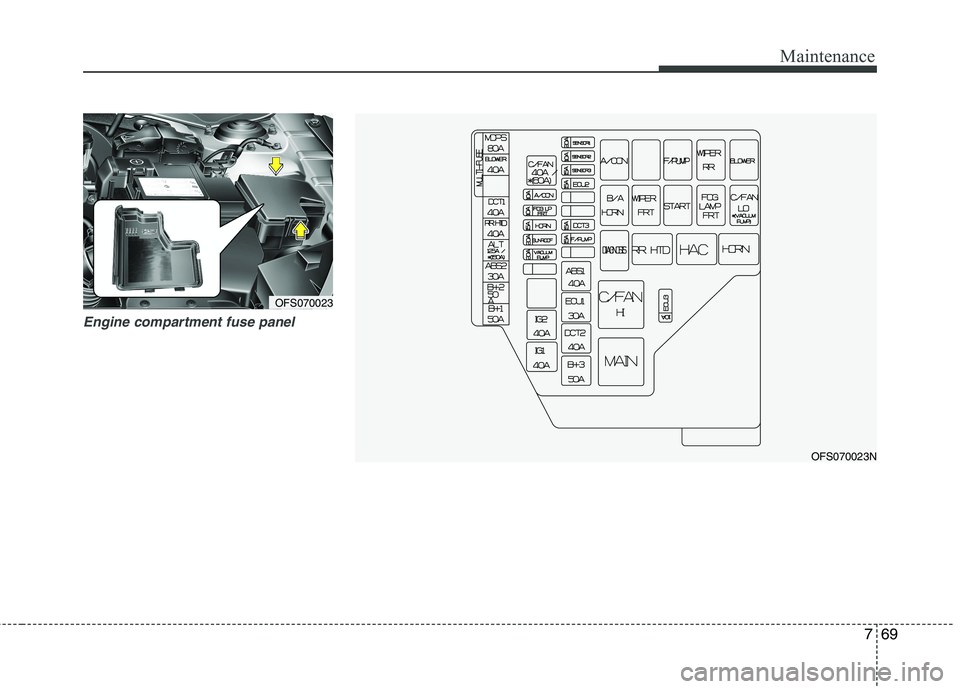
769
Maintenance
Engine compartment fuse panel
OFS070023
OFS070023N
Page 335 of 372

Maintenance
70 7
Engine compartment main fuse panel
Description Fuse rating Protected component
MULTI
FUSEMDPS 80A EPS Control Module
BLOWER 40A Engine Room Fuse & Relay Box (Blower Relay)
EcoShift dual clutch
transmission 1 (GDI)40A TCM
RR HTD 40A Engine RoomFuse & Relay Box (Rear Defogger Relay)
ALTGDI 125A
Engine RoomFuse & Relay Box (Multi Fuse - EcoShift dual clutch transmission 1,
MDPS, RR HTD, BLOWER), Alternator
T-GDI 150A
ABS 2 30A Multipurpose Check Connector, ESC Module
B+ 2 50ASmart Junction Box (Power Window Relay, IPS Control Module (ARISU LT),
Fuse - SAFETY POWER WINDOW, AMP)
B+ 150ALeak Current Autocut Device (Room Lamp Relay, Leak Current Autocut Switch,
Fuse - INTERIOR LAMP, MULTIMEDIA, MEMORY ), Fuse - S/HEATER
FUSEC/FANGDI 40A Engine Room Fuse & Relay Box (Cooling Fan (High) Relay, Cooling Fan (Low) Relay)
T-GDI 60AEngine Room Fuse & Relay Box (Cooling Fan (High) Relay)
A/CON 10AEngine RoomFuse & Relay Box (A/CON Relay)
FOG LP FRT 10AEngine RoomFuse & Relay Box (Fog Lamp Relay)
HORN 15AEngine RoomFuse & Relay Box (Burglar Alarm Horn Relay, Horn Relay)
SUNROOF 20A Panorama Sunroof Motor
IG 2 40AIgnition Switch, PDM Relay Box (IG 2 Relay),
Engine Room Fuse & Relay Box (Start Relay)
IG 1 40A Ignition Switch, PDM Relay Box (IG 1 Relay, ACC Relay)
Page 336 of 372

771
Maintenance
Description Fuse rating Protected component
FUSESENSOR 1 20A ECM
SENSOR 2GDI 10AOil Control Valve #1 (Intake)/#2 (Exhaust), Purge Control Solenoid Valve,
Variable Intake Solenoid Valve, Canister Close Valve,
Engine Room Fuse & Relay Box (A/CON Relay)
T-GDI 10AOil Control Valve #1 (Intake)/#2 (Exhaust), Purge Control Solenoid Valve,
Variable Intake Solenoid Valve, Canister Close Valve,
Engine Room Fuse & Relay Box (A/CON Relay), Waste gate valve, Recirulation valve
SENSOR 3 15A ECM, Oxygen Sensor (Up)/(Down), Engine Room Fuse & Relay Box (HAC Relay)
ECU 2 15A ECM
EcoShift dual clutch
transmission 3 (GDI)15A TCM
F/PUMP 15A Engine Room Fuse & Relay Box (Fuel Pump Relay)
ABS 1 40A ESC Module
ECU 1 30A Engine Room Fuse & Relay Box (Engine Conrol Relay, Fuse - ECU 2, ECU 3)
EcoShift dual clutch
transmission 2 (GDI)40A TCM
B+ 3 50ASmart Junction Box (Tail Lamp Relay, IPS Control Module (ARISU RT),
Fuse - STOP LP, SMART KEY 1/2, INVERTER 2, DR LOCK )
ECU 3 10A Sport Mode Switch
VACUUM PUMP
(T-GDI)20A Engine Room Fuse & Relay Box (Vacuum Pump Relay)
Page 345 of 372
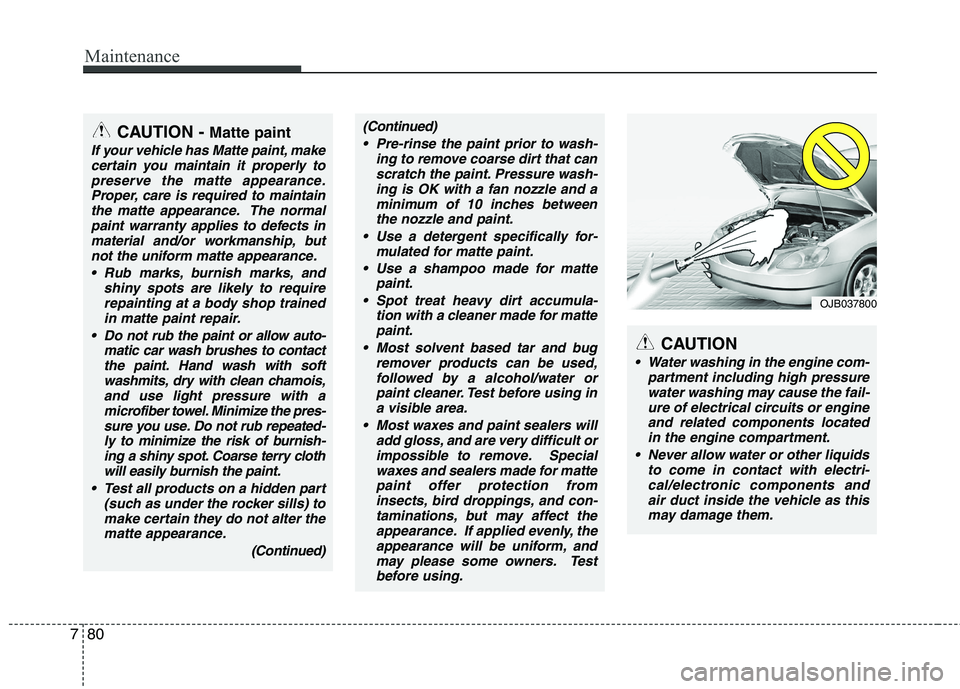
Maintenance
80 7
CAUTION
Water washing in the engine com-
partment including high pressure
water washing may cause the fail-
ure of electrical circuits or engine
and related components located
in the engine compartment.
Never allow water or other liquids
to come in contact with electri-
cal/electronic components and
air duct inside the vehicle as this
may damage them.
OJB037800
CAUTION - Matte paint
If your vehicle has Matte paint, make
certain you maintain it properly to
preserve the matte appearance.
Proper, care is required to maintain
the matte appearance. The normal
paint warranty applies to defects in
material and/or workmanship, but
not the uniform matte appearance.
Rub marks, burnish marks, and
shiny spots are likely to require
repainting at a body shop trained
in matte paint repair.
Do not rub the paint or allow auto-
matic car wash brushes to contact
the paint. Hand wash with soft
washmits, dry with clean chamois,
and use light pressure with a
microfiber towel. Minimize the pres-
sure you use. Do not rub repeated-
ly to minimize the risk of burnish-
ing a shiny spot. Coarse terry cloth
will easily burnish the paint.
Test all products on a hidden part
(such as under the rocker sills) to
make certain they do not alter the
matte appearance.
(Continued)
(Continued)
Pre-rinse the paint prior to wash-
ing to remove coarse dirt that can
scratch the paint. Pressure wash-
ing is OK with a fan nozzle and a
minimum of 10 inches between
the nozzle and paint.
Use a detergent specifically for-
mulated for matte paint.
Use a shampoo made for matte
paint.
Spot treat heavy dirt accumula-
tion with a cleaner made for matte
paint.
Most solvent based tar and bug
remover products can be used,
followed by a alcohol/water or
paint cleaner. Test before using in
a visible area.
Most waxes and paint sealers will
add gloss, and are very difficult or
impossible to remove. Special
waxes and sealers made for matte
paint offer protection from
insects, bird droppings, and con-
taminations, but may affect the
appearance. If applied evenly, the
appearance will be uniform, and
may please some owners. Test
before using.
Page 350 of 372
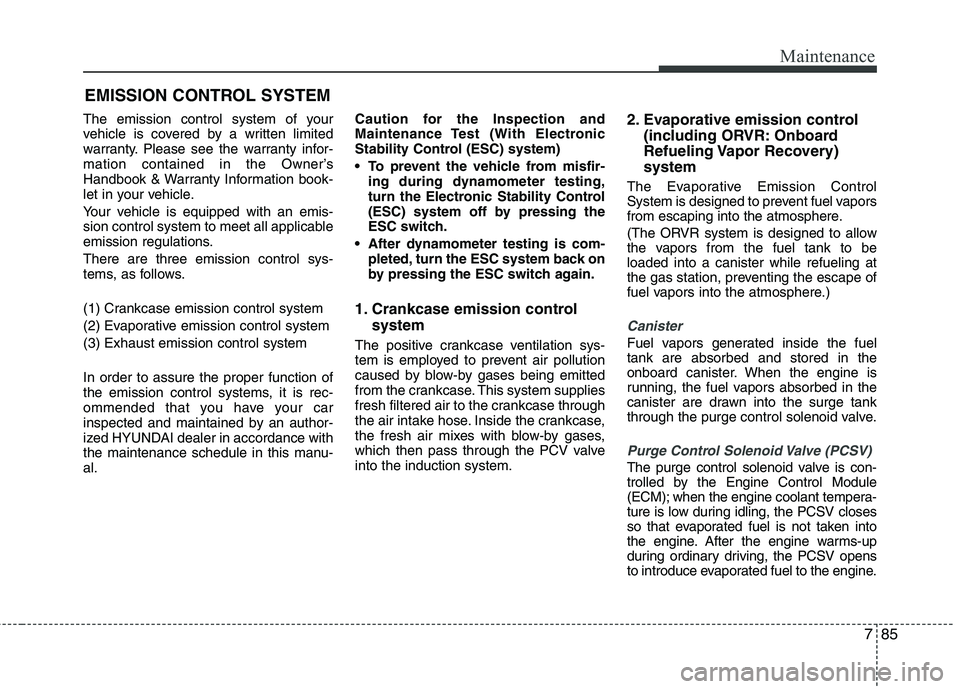
785
Maintenance
EMISSION CONTROL SYSTEM
The emission control system of your
vehicle is covered by a written limited
warranty. Please see the warranty infor-
mation contained in the Owner’s
Handbook & Warranty Information book-
let in your vehicle.
Your vehicle is equipped with an emis-
sion control system to meet all applicable
emission regulations.
There are three emission control sys-
tems, as follows.
(1) Crankcase emission control system
(2) Evaporative emission control system
(3) Exhaust emission control system
In order to assure the proper function of
the emission control systems, it is rec-
ommended that you have your car
inspected and maintained by an author-
ized HYUNDAI dealer in accordance with
the maintenance schedule in this manu-
al.Caution for the Inspection and
Maintenance Test (With Electronic
Stability Control (ESC) system)
To prevent the vehicle from misfir-
ing during dynamometer testing,
turn the Electronic Stability Control
(ESC) system off by pressing the
ESC switch.
After dynamometer testing is com-
pleted, turn the ESC system back on
by pressing the ESC switch again.
1. Crankcase emission control
system
The positive crankcase ventilation sys-
tem is employed to prevent air pollution
caused by blow-by gases being emitted
from the crankcase. This system supplies
fresh filtered air to the crankcase through
the air intake hose. Inside the crankcase,
the fresh air mixes with blow-by gases,
which then pass through the PCV valve
into the induction system.
2. Evaporative emission control
(including ORVR: Onboard
Refueling Vapor Recovery)
system
The Evaporative Emission Control
System is designed to prevent fuel vapors
from escaping into the atmosphere.
(The ORVR system is designed to allow
the vapors from the fuel tank to be
loaded into a canister while refueling at
the gas station, preventing the escape of
fuel vapors into the atmosphere.)
Canister
Fuel vapors generated inside the fuel
tank are absorbed and stored in the
onboard canister. When the engine is
running, the fuel vapors absorbed in the
canister are drawn into the surge tank
through the purge control solenoid valve.
Purge Control Solenoid Valve (PCSV)
The purge control solenoid valve is con-
trolled by the Engine Control Module
(ECM); when the engine coolant tempera-
ture is low during idling, the PCSV closes
so that evaporated fuel is not taken into
the engine. After the engine warms-up
during ordinary driving, the PCSV opens
to introduce evaporated fuel to the engine.
Page 351 of 372
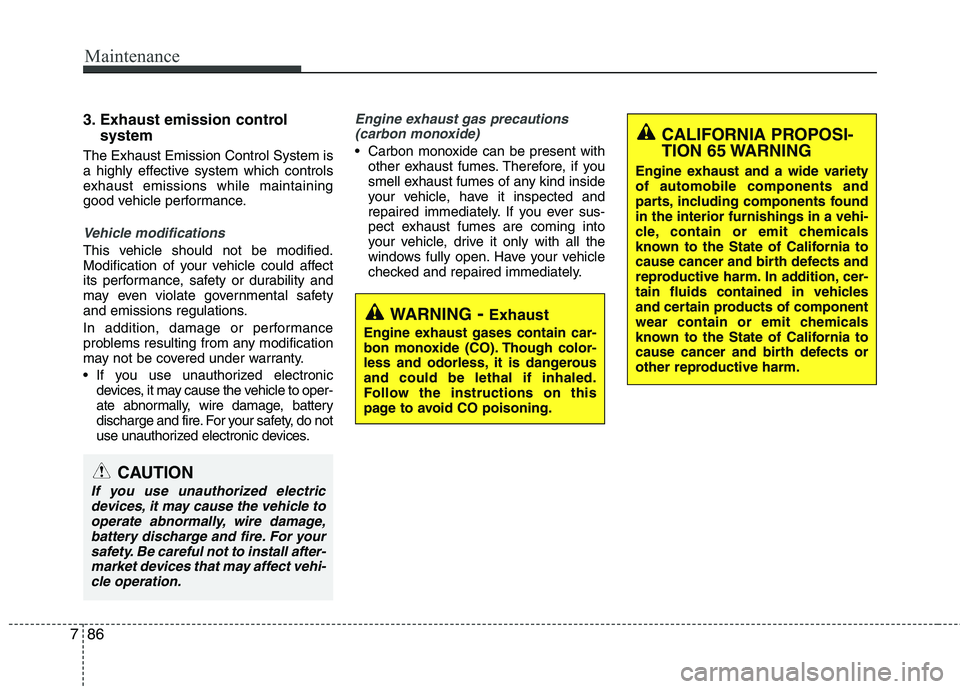
Maintenance
86 7
3. Exhaust emission control
system
The Exhaust Emission Control System is
a highly effective system which controls
exhaust emissions while maintaining
good vehicle performance.
Vehicle modifications
This vehicle should not be modified.
Modification of your vehicle could affect
its performance, safety or durability and
may even violate governmental safety
and emissions regulations.
In addition, damage or performance
problems resulting from any modification
may not be covered under warranty.
If you use unauthorized electronic
devices, it may cause the vehicle to oper-
ate abnormally, wire damage, battery
discharge and fire. For your safety, do not
use unauthorized electronic devices.
Engine exhaust gas precautions
(carbon monoxide)
Carbon monoxide can be present with
other exhaust fumes. Therefore, if you
smell exhaust fumes of any kind inside
your vehicle, have it inspected and
repaired immediately. If you ever sus-
pect exhaust fumes are coming into
your vehicle, drive it only with all the
windows fully open. Have your vehicle
checked and repaired immediately.
WARNING- Exhaust
Engine exhaust gases contain car-
bon monoxide (CO). Though color-
less and odorless, it is dangerous
and could be lethal if inhaled.
Follow the instructions on this
page to avoid CO poisoning.
CALIFORNIA PROPOSI-
TION 65 WARNING
Engine exhaust and a wide variety
of automobile components and
parts, including components found
in the interior furnishings in a vehi-
cle, contain or emit chemicals
known to the State of California to
cause cancer and birth defects and
reproductive harm. In addition, cer-
tain fluids contained in vehicles
and certain products of component
wear contain or emit chemicals
known to the State of California to
cause cancer and birth defects or
other reproductive harm.
CAUTION
If you use unauthorized electric
devices, it may cause the vehicle to
operate abnormally, wire damage,
battery discharge and fire. For your
safety. Be careful not to install after-
market devices that may affect vehi-
cle operation.
Page 352 of 372
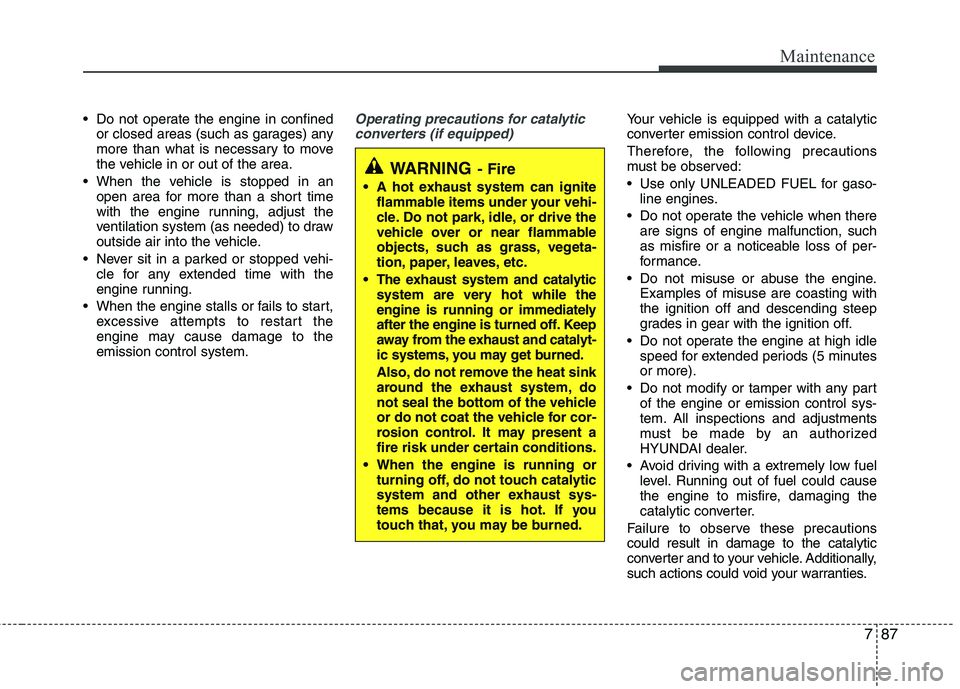
787
Maintenance
Do not operate the engine in confined
or closed areas (such as garages) any
more than what is necessary to move
the vehicle in or out of the area.
When the vehicle is stopped in an
open area for more than a short time
with the engine running, adjust the
ventilation system (as needed) to draw
outside air into the vehicle.
Never sit in a parked or stopped vehi-
cle for any extended time with the
engine running.
When the engine stalls or fails to start,
excessive attempts to restart the
engine may cause damage to the
emission control system.Operating precautions for catalytic
converters (if equipped)Your vehicle is equipped with a catalytic
converter emission control device.
Therefore, the following precautions
must be observed:
Use only UNLEADED FUEL for gaso-
line engines.
Do not operate the vehicle when there
are signs of engine malfunction, such
as misfire or a noticeable loss of per-
formance.
Do not misuse or abuse the engine.
Examples of misuse are coasting with
the ignition off and descending steep
grades in gear with the ignition off.
Do not operate the engine at high idle
speed for extended periods (5 minutes
or more).
Do not modify or tamper with any part
of the engine or emission control sys-
tem. All inspections and adjustments
must be made by an authorized
HYUNDAI dealer.
Avoid driving with a extremely low fuel
level. Running out of fuel could cause
the engine to misfire, damaging the
catalytic converter.
Failure to observe these precautions
could result in damage to the catalytic
converter and to your vehicle. Additionally,
such actions could void your warranties.
WARNING- Fire
A hot exhaust system can ignite
flammable items under your vehi-
cle. Do not park, idle, or drive the
vehicle over or near flammable
objects, such as grass, vegeta-
tion, paper, leaves, etc.
The exhaust system and catalytic
system are very hot while the
engine is running or immediately
after the engine is turned off. Keep
away from the exhaust and catalyt-
ic systems, you may get burned.
Also, do not remove the heat sink
around the exhaust system, do
not seal the bottom of the vehicle
or do not coat the vehicle for cor-
rosion control. It may present a
fire risk under certain conditions.
When the engine is running or
turning off, do not touch catalytic
system and other exhaust sys-
tems because it is hot. If you
touch that, you may be burned.
Page 354 of 372
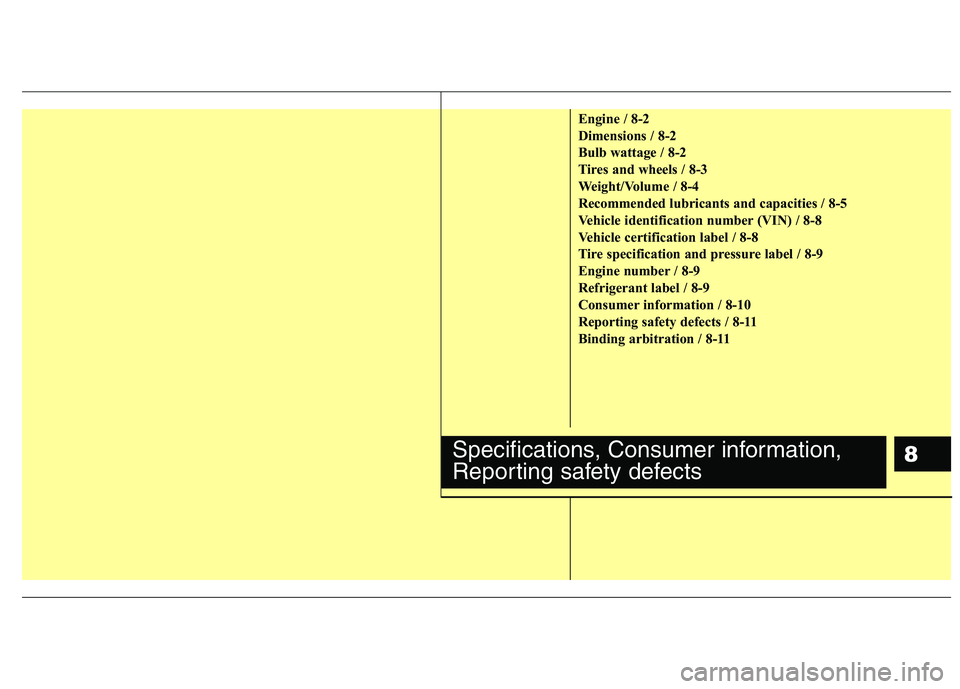
8
Engine / 8-2
Dimensions / 8-2
Bulb wattage / 8-2
Tires and wheels / 8-3
Weight/Volume / 8-4
Recommended lubricants and capacities / 8-5
Vehicle identification number (VIN) / 8-8
Vehicle certification label / 8-8
Tire specification and pressure label / 8-9
Engine number / 8-9
Refrigerant label / 8-9
Consumer information / 8-10
Reporting safety defects / 8-11
Binding arbitration / 8-11
Specifications, Consumer information,
Reporting safety defects